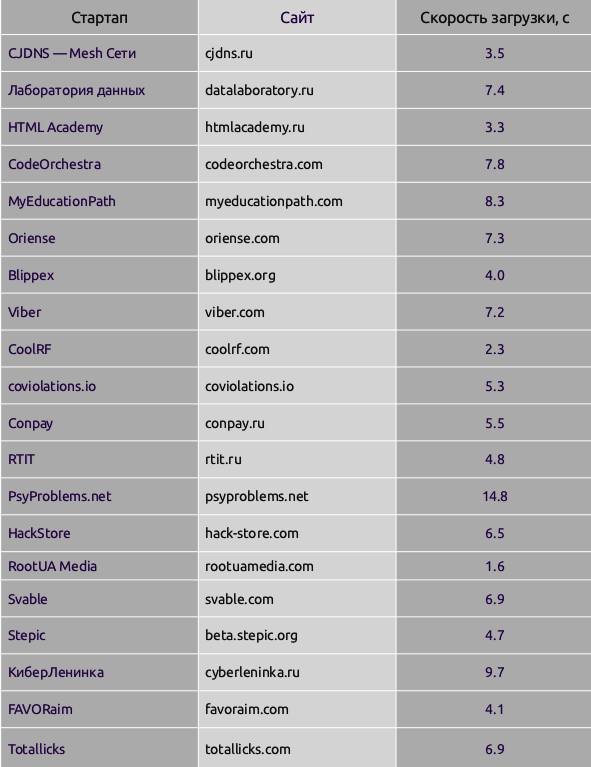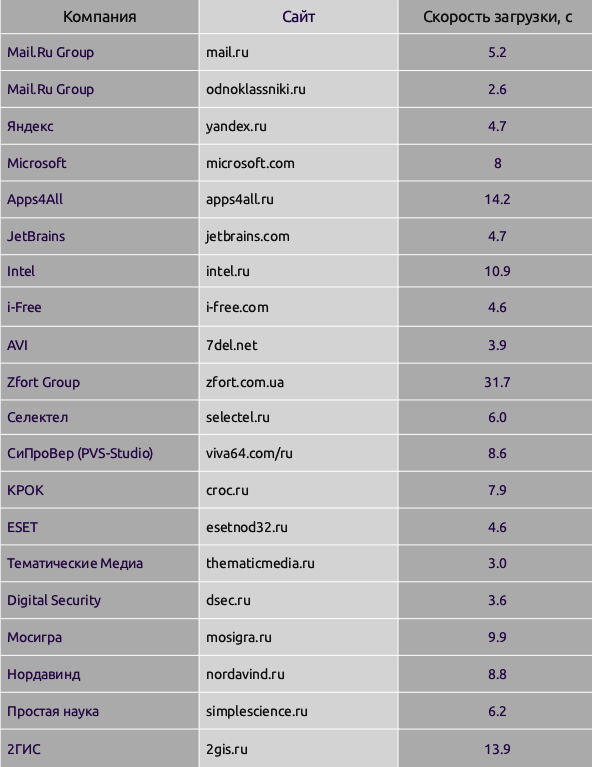Who is faster: startups or heavyweights?
It is patient to wait until the slow, but very necessary site in the era of broadband access is difficult to obtain, and if before 5-6 seconds the expectations were not particularly embarrassing, now this period of time is quite a cause for irritation. The trend is curious for us, in connection with which we decided to check what results the companies demonstrate today.
Measurements began with those inhabitants of the Network, which, by all laws of logic, should be fast and advanced - startups.
The participants in the experiment did not go far and took advantage of the Habraindex in the “Startups” section - the 20 highest positions in the list (as of November 1, 2013, it should be noted that during the preparation of the material there was some movement of companies between the lines in this rating).
For selected sites, we performed a performance test using the local WebPagetest instance .
Instance is deployed on a dedicated server in Moscow, the guaranteed network bandwidth is 100 Mbps. The location of the server and its characteristics increase the reliability of the result and avoid the situation when the test client is a bottleneck.
The measurements themselves were carried out in the Chrome browser, connection parameters: 5/1 Mbps, 28ms RTT. Three tests were run for each site, after which the publication of the median value of the total load time followed. In the WebPagetest documentation, this metric is defined approximately as follows:
“The duration of a full load is measured as the time interval from the start of navigation to the moment after which there is no network activity for 2 seconds. Typically, this activity includes any action that JavaScript triggers after an onload event on the site’s page. ”
And here is what happened as a result:

The results are mixed. A selection of startups turned out to be very mixed, as well as the sites themselves. The twenty measured resources included not only fully functional sites, but also simple stub sites. The latter (for example, rootuamedia.com , coolrf.com ) showed the best speed indicators, somewhat distorting the real picture. From the point of view of the optimal ratio of the level of complexity of the site and its loading time, resources such as htmlacademy.ru , blippex.org , favoraim.com , beta.stepic.org are favorably allocated .
We wondered what was happening with the larger companies and their sites? Do they show the best speed in the context of complicating the implementation of resources and the growing load in connection with the arrival of a significant number of users? In search of an answer, we went to the “Companies” section and again measured the first twenty (as of November 1, 2013), more precisely, 19 companies (2 sites from Mail.Ru Group).

Among the leaders of the second group of tested resources in the ratio of site complexity / load time are dsec.ru , esetnod32.ru , i-free.com , yandex.ru , jetbrains.com .
It is hardly possible to ensure absolutely equal conditions for each site when measuring performance.
So, for example, some developers optimize only the visible part of the site, neglecting the full load time. Social networking sites use a simple registration form as the main page, and information or entertainment portals host megabytes of media content on it. In addition, sites at the time of measurement can be overloaded due to the large influx of users.
If you do not take into account obvious extremes such as stub sites, social networking sites, or resources that take too long to load, then the performance level of tested startup sites and larger companies is comparable. Most resources are invested in critical load times (up to 10 seconds).
However, despite the many positive aspects, it is worth recognizing that both startups and large companies are still very far from the ideal 3 seconds of loading.
Methodology
Measurements began with those inhabitants of the Network, which, by all laws of logic, should be fast and advanced - startups.
The participants in the experiment did not go far and took advantage of the Habraindex in the “Startups” section - the 20 highest positions in the list (as of November 1, 2013, it should be noted that during the preparation of the material there was some movement of companies between the lines in this rating).
For selected sites, we performed a performance test using the local WebPagetest instance .
Instance is deployed on a dedicated server in Moscow, the guaranteed network bandwidth is 100 Mbps. The location of the server and its characteristics increase the reliability of the result and avoid the situation when the test client is a bottleneck.
The measurements themselves were carried out in the Chrome browser, connection parameters: 5/1 Mbps, 28ms RTT. Three tests were run for each site, after which the publication of the median value of the total load time followed. In the WebPagetest documentation, this metric is defined approximately as follows:
“The duration of a full load is measured as the time interval from the start of navigation to the moment after which there is no network activity for 2 seconds. Typically, this activity includes any action that JavaScript triggers after an onload event on the site’s page. ”
And here is what happened as a result:

The results are mixed. A selection of startups turned out to be very mixed, as well as the sites themselves. The twenty measured resources included not only fully functional sites, but also simple stub sites. The latter (for example, rootuamedia.com , coolrf.com ) showed the best speed indicators, somewhat distorting the real picture. From the point of view of the optimal ratio of the level of complexity of the site and its loading time, resources such as htmlacademy.ru , blippex.org , favoraim.com , beta.stepic.org are favorably allocated .
We wondered what was happening with the larger companies and their sites? Do they show the best speed in the context of complicating the implementation of resources and the growing load in connection with the arrival of a significant number of users? In search of an answer, we went to the “Companies” section and again measured the first twenty (as of November 1, 2013), more precisely, 19 companies (2 sites from Mail.Ru Group).

Among the leaders of the second group of tested resources in the ratio of site complexity / load time are dsec.ru , esetnod32.ru , i-free.com , yandex.ru , jetbrains.com .
And in conclusion...
It is hardly possible to ensure absolutely equal conditions for each site when measuring performance.
So, for example, some developers optimize only the visible part of the site, neglecting the full load time. Social networking sites use a simple registration form as the main page, and information or entertainment portals host megabytes of media content on it. In addition, sites at the time of measurement can be overloaded due to the large influx of users.
If you do not take into account obvious extremes such as stub sites, social networking sites, or resources that take too long to load, then the performance level of tested startup sites and larger companies is comparable. Most resources are invested in critical load times (up to 10 seconds).
However, despite the many positive aspects, it is worth recognizing that both startups and large companies are still very far from the ideal 3 seconds of loading.
